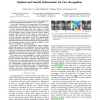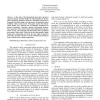135
Voted
FGR
2011
IEEE
14 years 4 months ago
2011
IEEE
— Matching images with large geometric and iconic changes (e.g. faces under different poses and facial expressions) is an open research problem in computer vision. There are two ...
158
click to vote
FGR
2011
IEEE
14 years 4 months ago
2011
IEEE
— In this paper we propose a method that exploits 3D motion-based features between frames of 3D facial geometry sequences for dynamic facial expression recognition. An expressive...
152
Voted
FGR
2011
IEEE
14 years 4 months ago
2011
IEEE
—An expression can be approximated by a sequence of temporal segments called neutral, onset, offset and apex. However, it is not easy to accurately detect such temporal segments ...
138
Voted
FGR
2011
IEEE
14 years 4 months ago
2011
IEEE
Abstract— We propose a system for human computer interaction via 3D hand movements, based on a combination of visual tracking and a cheap, off-the-shelf, accelerometer. We use a ...
142
Voted
FGR
2011
IEEE
14 years 4 months ago
2011
IEEE
— In this work, we present novel warping algorithms for full 2D pixel-grid deformations for face recognition. Due to high variation in face appearance, face recognition is consid...
169
click to vote
FGR
2011
IEEE
14 years 4 months ago
2011
IEEE
— In many visual multi-object tracking applications, the question when to add or remove a target is not trivial due to, for example, erroneous outputs of object detectors or obse...
143
Voted
FGR
2011
IEEE
14 years 4 months ago
2011
IEEE
— Despite major advances within the affective computing research field, modelling, analysing, interpreting and responding to naturalistic human affective behaviour still remains...
135
Voted
FGR
2011
IEEE
14 years 4 months ago
2011
IEEE
— This work details the authors’ efforts to push the baseline of expression recognition performance on a realistic database. Both subject-dependent and subject-independent emot...
143
Voted
FGR
2011
IEEE
14 years 4 months ago
2011
IEEE
— Is the study of the dimensional space that is meant to represent human emotions helpful in understanding the mechanisms underlying emotional processes? Emotional experience is ...
118
Voted
FGR
2011
IEEE
14 years 4 months ago
2011
IEEE



